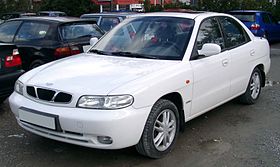Daewoo Nubira
| Daewoo Nubira | |
|---|---|
 |
|
| Overview | |
| Manufacturer | Daewoo |
| Also called | Doninvest Orion |
| Production | 1997–2002 (South Korea) 1997–present (CKD and license-built models) |
| Assembly |
Gunsan, South Korea Cairo, Egypt (Daewoo Motors Egypt, 1998-2012) Craiova, Romania (Rodae) Zaporizhia, Ukraine (AvtoZAZ) Warsaw, Poland (FSO) Hanoi, Vietnam (VIDAMCO) |
| Designer | I.DE.A Institute |
| Body and chassis | |
| Class | D-segment |
| Body style | 4-door sedan 5-door hatchback 5-door station wagon |
| Layout | Front-engine, front-wheel-drive |
| Powertrain | |
| Engine | |
| Transmission | |
| Dimensions | |
| Wheelbase | 2,570 mm (101.2 in) |
| Length | 4,247 mm (167.2 in) (hatchback) 4,468 mm (175.9 in) (1997–00 sedan) 4,514 mm (177.7 in) (1997–00 wagon) 4,496 mm (177.0 in) (2000–02 sedan) 4,547 mm (179.0 in) (2000–02 wagon) |
| Width | 1,699 mm (66.9 in) 1,720 mm (67.7 in) (2000–02 wagon) |
| Height | 1,425 mm (56.1 in) (1997–00) 1,433 mm (56.4 in) (1997–00 wagon) 1,430 mm (56.3 in) (2000–02 sedan) 1,471 mm (57.9 in) (2000–02 wagon) |
| Chronology | |
| Predecessor | Daewoo Nexia |
| Successor | Daewoo Lacetti |
The Daewoo Nubira is a compact car which was produced by South Korean automaker Daewoo from 1997 to 2002 as a sedan, Hatchback, and Station wagon.
Daewoo Nubira (J100 platform) was released in 1997 reflecting Daewoo's new found design and manufacturing prowess. Built in Kunsan, South Korea in a factory equipped with sophisticated laser-guided robots, it was developed as a replacement for the Daewoo Nexia and styled in Italy by Italian I.DE.A Institute. Engineering was carried out and overseen by former Porsche engineer Ulrich Bez (later of Aston Martin) using experience Daewoo gained from manufacturing previous GM platforms. The name Nubira (누비라) is the command form of the Korean verb Nubida (누비다), meaning to crisscross. Thus the name was chosen to convey the aspiration that this car would be seen crisscrossing every corner of the globe.
The Nubira II (J150) was released for model year 2000. Over 90 improvements were made by Daewoo's Worthing Technical Centre in the United Kingdom, including an increase in passenger space and a decrease in noise, harshness and vibration (by adding a fourth engine mount and retuning the intake resonators for example). Offset crash performance was further improved in the second generation, as demonstrated by Australian ANCAP tests, though it fell well short of exemplary performance. The exterior was reworked, creating a more dynamic upright and swept look of the era, a design later seen reflected by the Lexus ES350 and 2004 Mitsubishi Diamante.
In the United States, the Nubira was marketed with Daewoo's smaller subcompact Lanos and midsize Leganza. Daewoo had a difficult time entering the US auto market due to financial trouble at home; with 2002 being the last model year available due to bankruptcy and a lack of new product. In North America, the cars are relatively obscure, if not rare, and sourcing parts for them became relatively difficult; though many powertrain parts were shared worldwide with other GM platforms (Opel, Holden, Isuzu).
Buyers could opt for either the base SE models, (mid range SX only available for 1999) or the premium CDX with standard features such as ABS, heated mirrors, cruise control, in-dash CD player and optional leather seating and power sunroof.
...
Wikipedia
